Greek viticultural history dates back at least to the 16th century BC. Today, Greece ranks in the upper middle range as a wine producer worldwide, with a vineyard area of around 117,000 hectares (2007) and a volume of around 3.5 million hectolitres (2007). Most of the vineyards are located near the coast, although vineyards are often found at higher altitudes. The country is divided into a total of nine wine-growing regions, in which about 300 domestic as well as international grape varieties are cultivated.
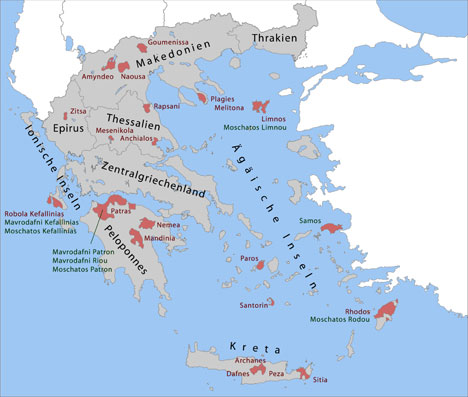 |
| The wine regions of Greece (Source: Pitichinaccio/Wikipedia) |
Northern Greece has four wine-growing regions: Thrace in the northeast, Macedonia in the north, and Epirus and Thessaly in the northwest. The total cultivated area is around 10,000 hectares (2011), and the natural conditions for viticulture are basically favourable: a temperate, sufficiently humid climate and fertile soils create good growing conditions for the vegetation. The four northern Greek wine regions, which are described in more detail below, sometimes have grape varieties that only grow in a small area and produce growths with their own unique character. Autochthonous grape varieties indigenous to the whole of Greece are, above all, Xinomavro and Limnio as red varieties and the white Assyrtiko, Athiri, Roditis, Malagousia and also Moschato.
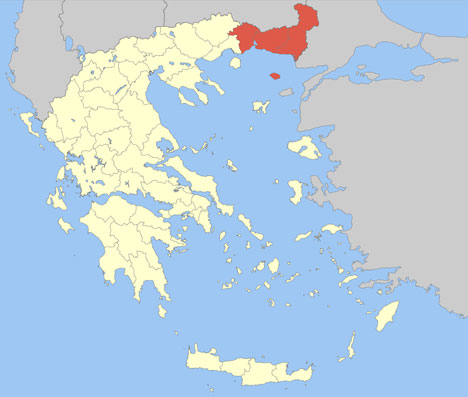 |
| The wine region of Thrace (Source: Pitichinaccio/Wikipedia) |
Thrace is located in the extreme northeast of Greece and borders Turkey to the west and Bulgaria to the south. With around 600 hectares (2011), the vineyard area is rather small. The warm, dry climate is tempered by northerly winds from higher altitudes, but also by sea breezes from the south. The limestone and sandy soils are partly interspersed with slate and iron, and alluvial soils predominate in the coastal areas. There is no protected designation of origin in Thrace, but there are three indications of origin for country wines: Thrakikos (for wines from the entire region), Ismarikos (for wines from the regional district of Rodopi in central Thrace) and Avdira (for wines from the regional district of Xanthi in western Thrace).
Thracian wines were already praised by the poet Homer in the 8th century BC, and red, rosé and white wines are produced today. Besides Xinomavro and Limnio, the local varieties Mavroudi and Pamidi as well as the international varieties Cabernet Sauvignon, Carignan, Grenache, Merlot and Syrah are cultivated as red grape varieties. White grape varieties include Assyrtiko, Athiri, Malagousia and Roditis, as well as the autochthonous Zoumiatiko, Chardonnay and Sauvignon Blanc.
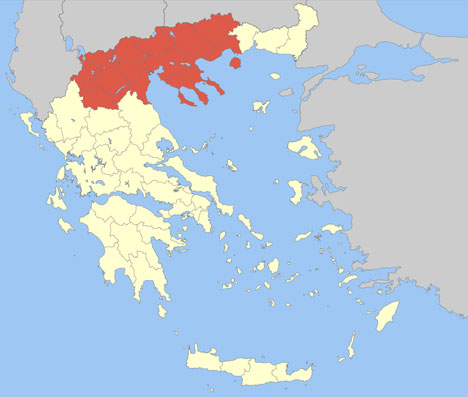 |
| The wine region of Macedonia (Source: Pitichinaccio/Wikipedia) |
Macedonia is centrally located in northern Greece and borders Albania, the Former Yugoslav Republic of Macedonia (FYROM) and Bulgaria to the south. On the one hand, there are mountains in the west of the region, on the other hand, Macedonia is also home to the largest plain in Greece. Vines grow on about 7,200 hectares, there is a continental climate with hot summers, cold winters and sufficient humidity. The soils are characterised by sand and clay, while the coast is dominated by alluvial soil.
Macedonia has four protected designations of origin: Amynteon, Goumenissa, Naoussa and Playies Meliton. The Amynteon appellation is located in the Florina regional district in northwestern Macedonia, around Lake Vegoritis. The only rosé sparkling wine in Greece with a protected designation of origin also comes from Amynteon. The Goumenissa appellation is located in the west of the northern Macedonian regional district of Kilkis, at the foot of Mount Paikon and near the town of Goumenissa. The Naoussa appellation is located in the regional district of Imathia, on the western edge of the Central Macedonian Plain, and extends around the town of Naoussa at the foot of Mount Vermion. The Playies Meliton appellation (also Côtes de Meliton) is located in the regional district of Chalkidiki on the slopes of Mount Meliton on the Aegean peninsula of Sithonia.
Macedonia produces predominantly red wines, mainly from Xinomavro. Other red grape varieties are Limnio and Negoska, which is often blended with Xinomavro, as well as Cabernet Sauvignon, Grenache, Merlot, Syrah and Cabernet Franc. Rosé still and sparkling wines as well as white wines are also produced, the latter from Roditis, Athiri, Assyrtiko and Moschato as well as from Sauvignon Blanc and Chardonnay.
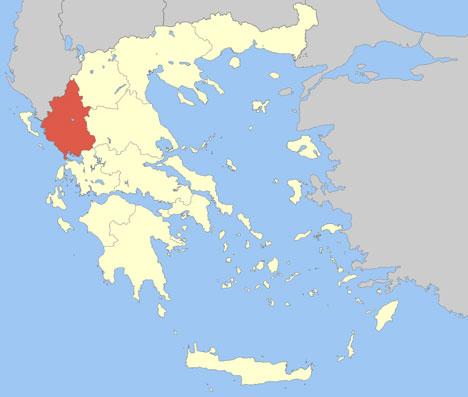 |
| The wine region of Epirus (Source: Pitichinaccio/Wikipedia) |
Epirus, located in the extreme northwest of Greece on the border with Albania, is characterised by a rugged and mountainous landscape. In the barren region, around 500 hectares are planted with vines that grow predominantly on sandy and clay soils in a continental, humid climate. Zitsa, the only protected designation of origin in Epirus, is located in the regional district of Ioannina in the centre of the region near Lake Pamvotida. In addition, the area has the Metsovo designation of origin for country wines.
In Epirus, mainly white and sparkling wines are produced from the autochthonous grape variety Debina, which present themselves with apple aromas and a distinct acid bite. The white varieties Gewürztraminer, Riesling and Sauvignon Blanc are also cultivated; red wines are made from Bekari, Vlachiko, Agiorgitiko and Cabernet Sauvignon.
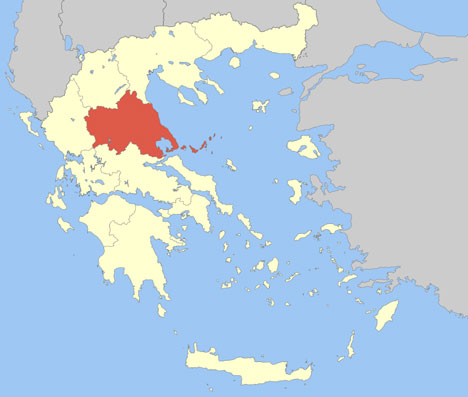 |
| The wine region of Thessaly (Source: Pitichinaccio/Wikipedia) |
Thessaly borders Macedonia to the north and Epirus to the west, with the region of Central Greece to the south. Thessaly also has different landscape formations with wide plains on the one hand and the Olympus mountains on the east coast on the other. The vineyards cover 3,500 hectares, with the grapes thriving in a mild, humid climate and the vines on ferruginous slate soils with a sandy-loam subsoil; alluvial soil is also prevalent on the coast.
Thessaly has three protected designations of origin: Anchialos, Messenikola and Rapsani. The white wine appellation Anchialos is located in the regional district of Magnisia in the southeast of the region. Messenikola, located in the western Thessalonian regional district of Karditsa at an altitude of up to 800 metres, is also a red wine appellation, as is the better-known designation of origin Rapsani, whose vineyards are located in the north-eastern Thessalonian regional district of Larisa at an altitude of up to 700 metres at the foot of Mount Olympus.
The red wines of Thessaly are produced from the grape varieties Limnio, Limniona (despite the similar name, not related to Limnio), Cabernet Sauvignon, Syrah, Merlot, Cinsault and Muscat d'Hambourg. In the Rapsani appellation, the red grapes Xinomavro, Krassato and Stavroto are blended together. The white grape varieties grown are Assyrtiko, Roditis, Batiki, Savatiano and Chardonnay. Savatiano and Roditis are the blending partners for the white wine from the Anchialos appellation.
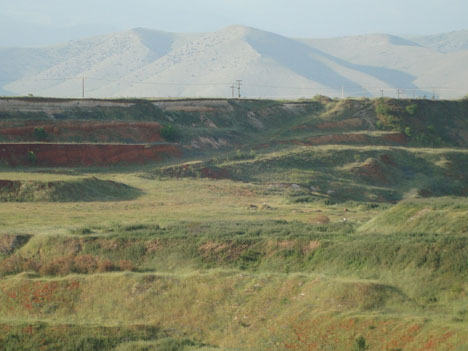 |
| Wine landscape in Amynteon% Macedonia (Source: Alpha Estate) |
The first wine law in Greece was already established 2,400 years ago. Today, wine legislation is based on the quality system that was established in the early 1970s on the French model. This system regulates, among other things, the admission of grape varieties, the maximum yield per hectare, the minimum must weight and prescribed ripening times. After the EU wine market reform of 2007 changed the wine designation law, new designations for the individual quality levels have also applied in Greece since autumn 2009; however, the previous designations may continue to be used at least until the end of 2011.
The previous category of table wine was renamed from Epitrapezios Oinos to Oinos (pronounced "Inos"). Kava is the former name for a table wine of higher quality that has been stored for a longer period of time. The category of country wine (see also the magazine article "The new wine designation law - terms and background") was previously called Topikos Oinos and now corresponds to wine with a protected geographical indication, in Greek Prostatevomenis Geografikis Endixis, abbreviated PGE. In Northern Greece, there are around 100 PGE appellations of different sizes - from the four geographical regions (Thrace, Macedonia, Thessaly, Epirus) to the regional districts (Thessaloniki, Chalkidiki etc.) to individual small areas (Mount Athos, Avdira, Metsovo, Krania etc.). A list of all PGE appellations can be found in the magazine article "Quality and Pleasure Initiative for the Northern Greek Wines".
The quality wine category, previously called Onomasia Proléfseos Anoteras Piotitos (OPAP) and for sweet wines Onomasia Proléfseos Eleghomeni (OPE), now corresponds to the wines with protected indication of origin, in Greek Prostatevomenis Onomasias Proléfsis (POP). The eight POP appellations in northern Greece are, as already shown, Amynteon, Goumenissa, Naoussa and Playies Meliton in Macedonia, Anchialos, Messenikola and Rapsani in Thessaly, and Zitsa in Epirus. For matured wines, according to the previous regulation, the designations Epilegmenos for Reserve (white wines at least two years, red wines at least three years of maturity) and Idika Epilegmenos for Grande Reserve (white wines at least three years, red wines at least four years of maturity) are additionally available. The Greek name for sparkling wine is Aphrodis Oinos or Sampania.
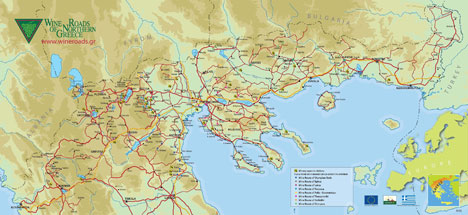 |
| The Wine Roads of Northern Greece (Source: Wine Roads of Northern Greece) |
The authoritative body in northern Greek viticulture is the "Wines of North Greece" association, which was founded in 1993 by 13 ambitious winegrowers. The organisation, which today has 37 member wineries, aims not only at modern, dynamic viticulture and the high quality of the wines produced, but also at the promotion of Northern Greek wines on export markets and the development of enotourism in Northern Greece. Since 2000, the association has organised the "International Wine Competition of Thessaloniki" every year in March, where oenologists, sommeliers and specialised journalists from all parts of the world judge Greek wines for three days.
In addition, 39 wineries have joined forces with hospitality and other businesses to form the "Wine Routes of Northern Greece" association. With their help, pleasure-loving tourists to Greece can tour eight wine routes through the wine-growing regions, leading to wineries, restaurants, hotels and cultural-historical sights.
In October 2011, 21 members of the winegrowers' association presented themselves at two city tastings of northern Greek wines organised by "Wines of North Greece" together with Wein-Plus in Munich and Wiesbaden. These events were a great success with around 300 trade visitors from the retail and gastronomy sectors, and numerous retailers who were able to convince themselves of the quality of the wines on site are now including growths from Northern Greece in their assortments. The city tastings were part of the quality and enjoyment initiative for the wines of Northern Greece, which Wein-Plus and the association jointly launched and plan to continue in 2012.
To the website of "Wines of North Greece", where a list of all association members is also available; the producers classified in the wine guide of Wein-Plus are assigned to the individual growing regions above (see glossary links in the respective boxes).
To the "Wine Roads of Northern Greece" website
All currently tasted wines from Thrace in the wine guide
All currently tasted wines from Macedonia in the wine guide